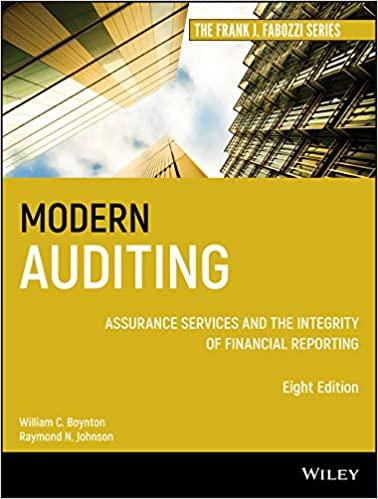Question
1110. This exercise uses the same fact setting as Exercise 11-9 except that items 1 and 2 are changed to be consistent with a private
1110.
This exercise uses the same fact setting as Exercise 11-9 except that items 1 and 2 are changed to be consistent with a private institution.
The Great Lakes Maritime Institute is a private not-for-profit institution preparing cadets for careers in commercial shipping and includes instruction in piloting, navigation, maritime law, and other fields.
The Institute began the year with the following account balances:
| Beginning Balances July 1, 2016 | ||
| Debits | Credits | |
| Cash | $250,000 | |
| Student Accounts Receivable | 15,000 | |
| InvestmentsEndowment | 500,000 | |
| Restricted Cash | 250,000 | |
| Capital Assets | 1,000,000 | |
| Accumulated Depreciation | $350,000 | |
| Accounts Payable and Accrued Liabilities | 5,000 | |
| Deferred Revenues | 6,000 | |
| Permanently Restricted Net Assets | 500,000 | |
| Temporarily Restricted Net Assets | 250,000 | |
| Unrestricted Net Assets | 904,000 | |
The Institute received an unrestricted operating grant of $75,000 from the Maritime Shipping Association, a trade association for commercial shipping firms. Additionally, the Institute received unrestricted gifts of $10,000.
Items 315 are the same as in Exercise 11-9.
Required:
Prepare journal entries recording the events above for the year ending December 31, 2017.
Post the journal entries to T-accounts.
Prepare closing entries.
Prepare a Statement of Activity.
Prepare a Statement of Financial Position.
Prepare a Statement of Cash Flows.
Exercise 11-9
| Beginning Balances July 1, 2016 | ||
| Debits | Credits | |
| Cash | $250,000 | |
| Student Accounts Receivable | 15,000 | |
| InvestmentsEndowment | 500,000 | |
| Restricted Cash | 250,000 | |
| Capital Assets | 1,000,000 | |
| Accumulated Depreciation | $350,000 | |
| Accounts Payable and Accrued Liabilities | 5,000 | |
| Deferred Revenues | 6,000 | |
| Net Investment in Capital Assets | 650,000 | |
| Restricted Net Position | 750,000 | |
| Unrestricted Net Position | 254,000 | |
The Institute received a state appropriation of $75,000 and unrestricted gifts of $10,000.
The deferred revenue appearing on the beginning of the year trial balance represents the portion of summer school tuition received in the previous academic year that relates to classes held in the current year.
Students were billed for tuition and fees of $500,000 and room and board of $190,000. A total of $350,000 was received on student accounts throughout the year.
The Institute received $110,000 of Pell Grants during the academic year. These amounts were immediately applied to student accounts for amounts due for tuition and fees.
Students are awarded academic scholarships of $150,000, which are applied to their accounts. Additionally, several other students are hired by the Institute to work in the Institutes dining hall (auxiliary enterprise). As part of their compensation for working, tuition in the amount of $25,000 is waived.
The $250,000 restricted cash balance at the beginning of the year was donated for a new training ship. During the year an additional $250,000 donation was received.
The Institute signed a long-term note payable for $200,000. These funds, together with the restricted cash, were used to buy the training ship. The training ships expenses are classified as instruction.
During the year, $100,000 of cash and pledges for an additional $200,000 were received as a result of fund-raising campaigns to enhance the page 343Institutes endowment. By the terms of the agreement, such contributions are to remain permanently in the endowment. The $100,000 was immediately used to purchase additional investments.
By terms of the endowment agreement, interest and dividends received on the investments are restricted for need-based scholarships. Gains or losses from changes in the fair value of the investments, however, are not distributed but remain in the endowment. During the year, $27,000 of interest and dividends were received on endowment investments. At year-end, the fair value of the investments had increased by $4,000.
Expenses totaling $685,000 for salaries, supplies, utilities, and other items to be paid in cash are approved for payment through accounts payable. A total of $460,000 of outstanding accounts payable were paid by year-end. Although both GASB and FASB permit classification by natural category, the functional categories appearing below are recommended by NACUBO (amounts are assumed).
Included in the expenses recorded in the previous transactions are $125,000 incurred under federal and state government reimbursement-type grants. Bills were sent to the granting agencies, and $106,500 was received by the end of the year.
Step by Step Solution
There are 3 Steps involved in it
Step: 1

Get Instant Access to Expert-Tailored Solutions
See step-by-step solutions with expert insights and AI powered tools for academic success
Step: 2

Step: 3

Ace Your Homework with AI
Get the answers you need in no time with our AI-driven, step-by-step assistance
Get Started


